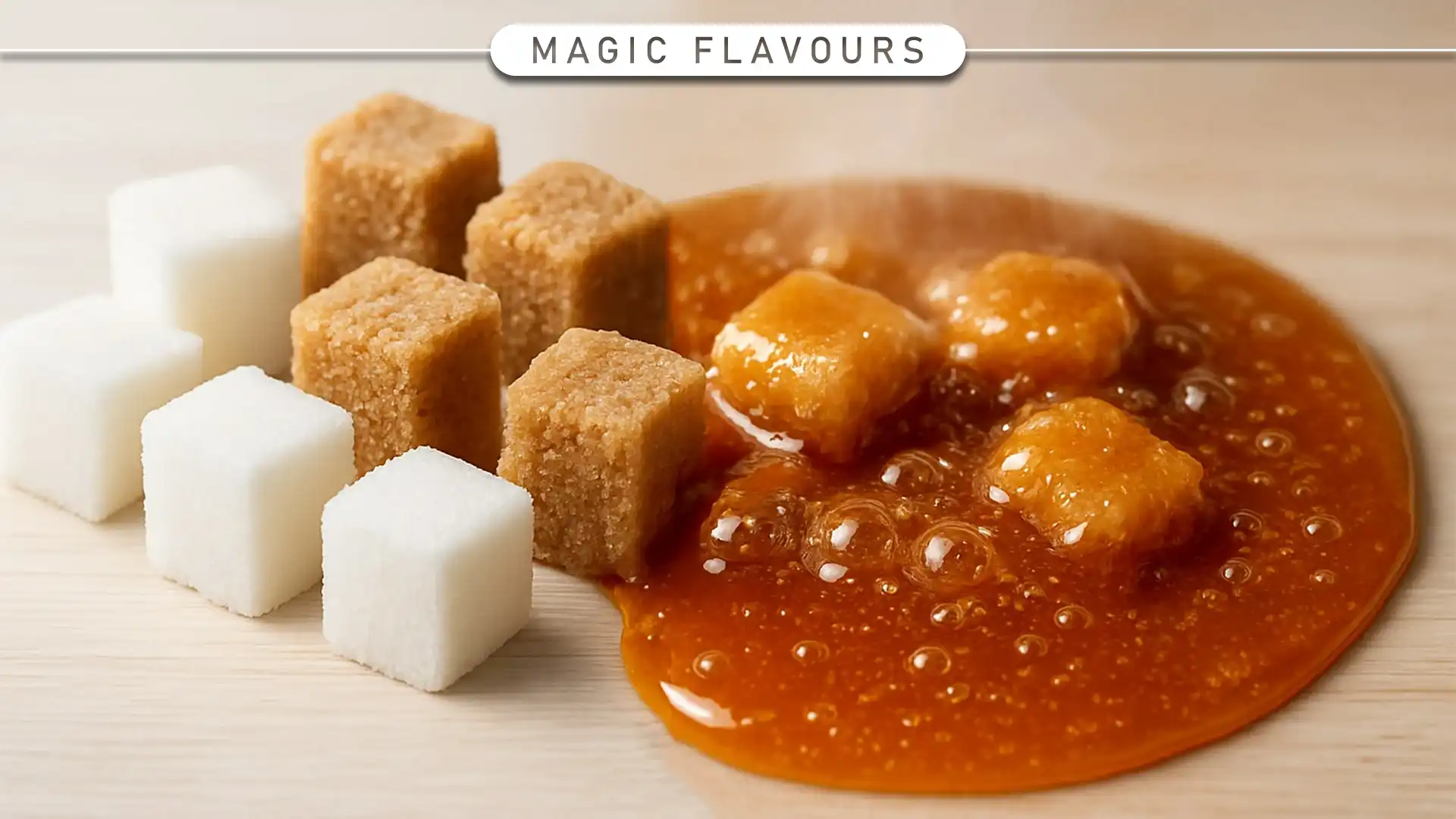1. Is Caramelizing Sugar a Chemical Change? The Complete Guide
Caramelizing sugar may seem like a simple kitchen trick, but it involves fascinating science. When sugar turns golden brown, it changes in ways that go beyond appearance. Therefore, asking whether caramelizing sugar is a chemical change opens the door to both cooking and chemistry.
At first glance, caramelization looks like sugar just melting under heat. However, as the temperature rises, the molecules start breaking apart. Consequently, new compounds form, creating the unique color, taste, and aroma we know as caramel.
Because caramelization produces entirely new substances, scientists classify it as a chemical change. Moreover, this transformation explains why caramel tastes richer and more complex than plain sugar. So, whether you are cooking desserts or studying science, caramelization offers a perfect example of chemistry in action.
2. What Happens When You Heat Sugar During Caramelizing?
The first step: melting sugar (a physical change)
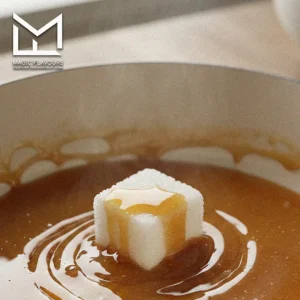
When sugar is first heated, it begins to melt into a clear liquid. At this stage, the sugar changes its form but not its identity. Therefore, scientists consider melting sugar a physical change rather than a chemical one.
In this process, the molecules stay exactly the same, and no new substances appear. Because only the physical state changes, the sugar remains sugar even after it melts. Consequently, you can cool the liquid and watch it turn back into crystals.
This reversible transformation highlights the key difference between physical and chemical changes. While caramelization creates new flavors and aromas, melting only alters texture. So, melting sugar sets the stage for what comes next without changing the sugar’s chemical makeup.
From Clear Liquid to Golden Brown: The Start of Caramelizing Sugar
Once melted sugar heats beyond a certain point, its transformation truly begins. At this stage, the clear liquid slowly turns golden brown. Therefore, this visible shift signals the start of the caramelization process.
As the temperature rises above 160°C, sugar molecules start breaking down. Because of this breakdown, new compounds form that create richer colors and deeper aromas. Consequently, the once simple liquid becomes more complex with every passing second.
The appearance of golden tones marks more than just a visual change. Instead, it reflects a fundamental chemical reaction taking place inside the sugar. So, the clear liquid’s journey into caramel shows us both beauty and science at work.
3. Physical vs. Chemical Change: The Key Difference in Caramelizing Sugar
What is a physical change?
A physical change happens when a substance alters its form but not its identity. For example, when ice melts, it becomes liquid water. However, it is still the same chemical substance, H₂O. Therefore, melting ice is a clear case of a physical change.
Another common example is dissolving sugar in water. In this process, the sugar crystals disappear into the liquid. Yet, the sugar molecules remain intact, and they can be recovered by evaporation. Consequently, no new substance forms during dissolving.
Physical changes are usually reversible, and they do not create new compounds. Because the chemical makeup stays the same, the substance can return to its original state. So, melting, dissolving, or breaking materials all fit into the category of physical changes.
What is a chemical change?
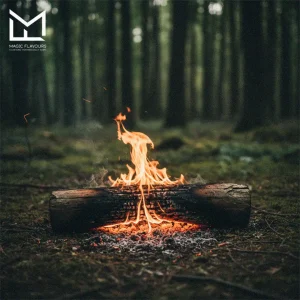
A chemical change occurs when a substance forms one or more entirely new substances. For instance, when iron rusts, it reacts with oxygen and moisture. Therefore, the shiny metal transforms into reddish-brown iron oxide, which is very different from iron itself.
Another strong example is burning wood. In this case, the wood reacts with oxygen and produces ash, smoke, and gases. Because new materials form that cannot revert to the original wood, burning clearly represents a chemical change.
Chemical changes often release heat, light, or color as signs of transformation. Since they create new substances, they are usually irreversible in everyday life. So, rusting, burning, and caramelizing sugar all showcase the unique power of chemical changes.
4. Where caramelization fits in
The Chemistry of Caramelizing Sugar Explained
Caramelization begins when sugar reaches high temperatures and its molecules start to break apart. As sucrose decomposes, it separates into glucose and fructose. Therefore, the sugar no longer exists in its original form.
Next, these smaller sugars undergo further reactions that create acids, esters, and aromatic compounds. Because of these new substances, caramel develops its signature flavor and golden-brown color. Consequently, the taste becomes richer and more complex.
This series of transformations shows that caramelization is not just melting sugar. Instead, it is a chemical process that builds entirely new compounds. So, caramelization represents the perfect mix of heat, chemistry, and flavor creation.
Breaking Down Sucrose into Glucose and Fructose During Caramelizing
When sugar heats to high temperatures, sucrose molecules start to split into glucose and fructose. This process, called thermal decomposition, marks the first step of caramelization. Therefore, the sugar’s original structure no longer exists.
As glucose and fructose form, they become more reactive under heat. Because these monosaccharides are smaller, they can undergo further chemical reactions. Consequently, they produce the flavors, aromas, and color changes we associate with caramel.
This breakdown is essential for caramel’s unique taste. Without splitting sucrose, the complex flavors and golden color could not develop. So, the transformation from sucrose to glucose and fructose is a critical chemical step in caramelization.
Formation of new compounds (flavor molecules, acids, esters)
As glucose and fructose react under heat, they form hundreds of new compounds. These include acids, esters, and aromatic molecules. Therefore, the flavor, color, and aroma of caramel emerge from chemical changes.
The acids contribute slight bitterness, while esters create fruity and floral notes. Because these compounds are entirely new, they make caramel taste very different from sugar. Consequently, caramel’s rich aroma and golden hue develop naturally during the reaction.
This complex chemistry explains why caramel cannot revert to plain sugar. Instead, the creation of flavor molecules highlights the chemical nature of caramelization. So, every sweet caramel note is a result of molecular transformation.
Why caramel smells and tastes different from sugar
Caramel smells and tastes different because heating sugar produces entirely new compounds. These molecules include acids, esters, and aromatic compounds. Therefore, the flavor and aroma are far more complex than plain sugar.
During caramelization, some reactions create nutty, fruity, or slightly bitter notes. Because these flavors did not exist in sugar, they signal a chemical change. Consequently, the final product offers a depth of taste that simple melting cannot achieve.
The color change also reflects chemical transformation. As sugar browns, it visually confirms the formation of new molecules. So, both taste and smell demonstrate that caramelization is a true chemical process.
The role of heat (temperature thresholds, around 160–180°C)
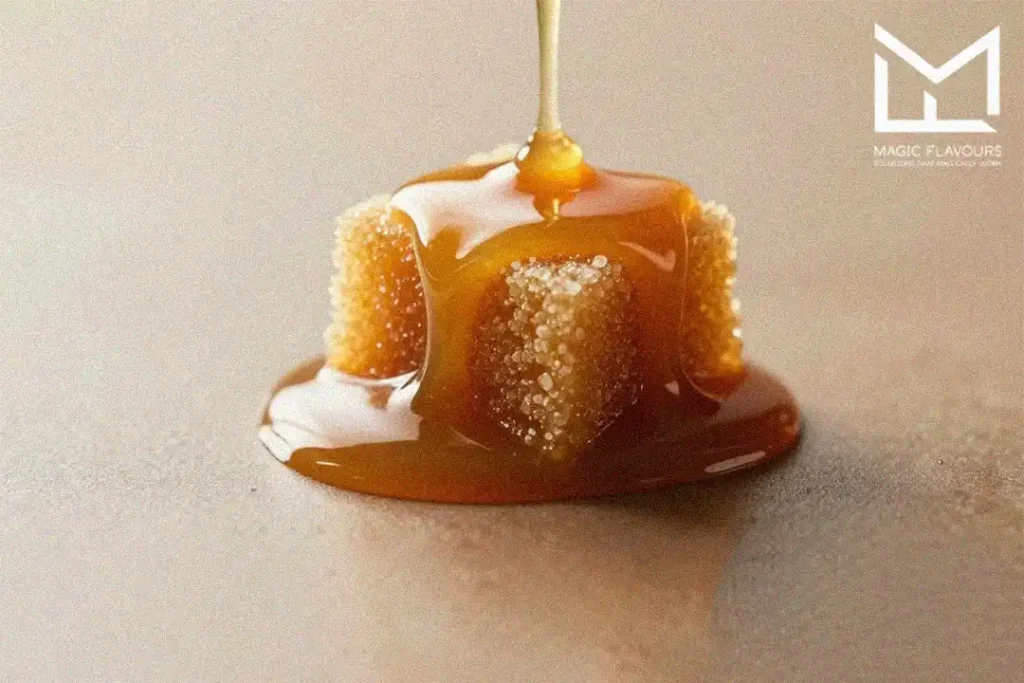
Heat plays a crucial role in caramelization by providing the energy sugar molecules need to break apart. When sugar reaches around 160–180°C, the process begins. Therefore, this temperature range is critical for chemical transformation.
Below this threshold, sugar simply melts without changing its structure. Because the molecules remain intact, no new flavors or colors appear. Consequently, achieving the right heat ensures that caramel develops properly.
Excessive heat can burn sugar, producing bitter compounds instead of pleasant caramel flavors. So, careful temperature control is essential to trigger the chemical reactions that create aroma, color, and taste. Heat truly drives the science behind caramelization.
5. Is Caramelizing Sugar a Chemical Change? The Final Answer
Yes, caramelizing sugar is a chemical change because it produces entirely new substances. As sucrose breaks down into glucose and fructose, new compounds form. Therefore, the sugar no longer remains the same at the molecular level.
This reaction creates the flavors, aromas, and colors that define caramel. Because these properties did not exist in the original sugar, the change cannot be reversed. Consequently, caramelization is clearly different from simple melting, which is a physical change.
In summary, caramelization combines heat and chemistry to transform sugar. So, whether in cooking or science, this process perfectly demonstrates a chemical change in action.
6. Everyday Examples of Caramelization
-
Caramel candies
Caramel candies are a delicious example of sugar’s chemical transformation. When sugar heats and melts, it undergoes caramelization, producing rich flavors and golden color. Therefore, the candy’s taste and aroma come directly from chemical changes in the sugar.
The process starts with melting sugar, then heating it to form new compounds. Because these molecules differ from plain sugar, caramel candies have a unique texture and flavor. Consequently, each bite highlights the science behind sweet treats.
Caramel candies show how heat and sugar combine to create entirely new substances. So, enjoying them is also appreciating a real-life chemical reaction in the kitchen.
• Crème brûlée
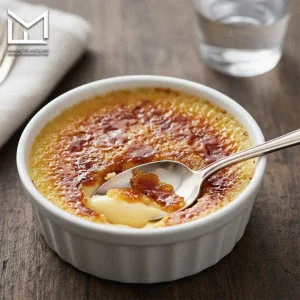
Crème brûlée perfectly showcases caramelization on the surface of desserts. When sugar on top is heated with a torch, it melts and browns. Therefore, a chemical change occurs, producing a crisp, flavorful crust.
The heat breaks sugar molecules into new compounds that create rich aromas and subtle bitterness. Because these flavors did not exist in raw sugar, the dessert gains depth and complexity. Consequently, each bite combines creamy custard with the science of caramelization.
This technique demonstrates how caramelization enhances both flavor and texture. So, Crème brûlée is not just a treat—it is chemistry in action on your plate.
• Caramelized onions
Caramelized onions show how sugar in vegetables undergoes chemical transformation. As onions cook slowly, their natural sugars break down and brown. Therefore, caramelization creates sweet, rich flavors that raw onions lack.
This process also produces new aromatic compounds, enhancing both taste and smell. Because these molecules did not exist in fresh onions, the change is chemical rather than physical. Consequently, slow cooking turns simple onions into a complex, savory ingredient.
Caramelized onions demonstrate how caramelization works beyond candy and desserts. So, even everyday cooking offers a delicious lesson in chemistry.
• Coffee roasting
Coffee roasting illustrates caramelization on a larger scale in beverages. As beans heat, their natural sugars break down and turn brown. Therefore, roasting triggers chemical changes that develop rich flavor and aroma.
During roasting, new compounds form, including acids and aromatic molecules. Because these substances did not exist in raw beans, the process is a chemical change. Consequently, roasted coffee gains depth, complexity, and a signature aroma.
This transformation shows how caramelization enhances taste in everyday drinks. So, enjoying a cup of coffee is also experiencing chemistry in action.
7. Why Caramelization Matters in Cooking
Flavor enhancement
Caramelization is essential for creating rich and complex flavors in cooking. As sugar breaks down, new compounds form that add depth and sweetness. Therefore, it transforms simple ingredients into more flavorful dishes.
This process also balances bitterness, acidity, and sweetness, creating a well-rounded taste. Because the flavors develop from chemical reactions, they cannot be achieved by adding raw sugar alone. Consequently, caramelization elevates both savory and sweet recipes.
By enhancing flavor naturally, caramelization allows chefs to create memorable dishes. So, understanding this process helps cooks maximize taste in everyday cooking.
Color and aroma creation
Caramelization produces appealing golden-brown colors that enhance a dish’s visual appeal. As sugar molecules react, they form pigments called melanoidins. Therefore, the change is chemical, not just aesthetic.
The process also releases aromatic compounds that enrich a dish’s smell. Because these new molecules did not exist in raw sugar, they create complex scents that delight the senses. Consequently, both color and aroma indicate that chemical reactions have occurred.
Chefs rely on these transformations to make food more inviting and flavorful. So, caramelization is as much about the senses as it is about chemistry.
Culinary creativity and science working together
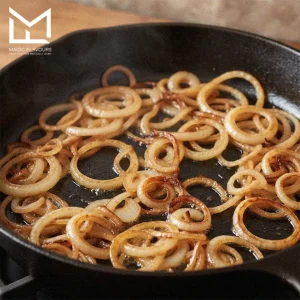
Caramelization shows how science enhances culinary creativity. Understanding chemical changes allows chefs to control flavor, color, and aroma. Therefore, cooking becomes both an art and a science.
By manipulating heat and timing, chefs can produce different caramel profiles. Because chemical reactions are predictable, creative techniques like torching or slow-cooking yield consistent results. Consequently, culinary innovation is guided by science.
This blend of creativity and chemistry elevates dishes from ordinary to extraordinary. So, caramelization proves that cooking is not just instinct—it is a precise, scientific craft.
8. FAQs About Caramelization
Is caramelization the same as the Maillard reaction?
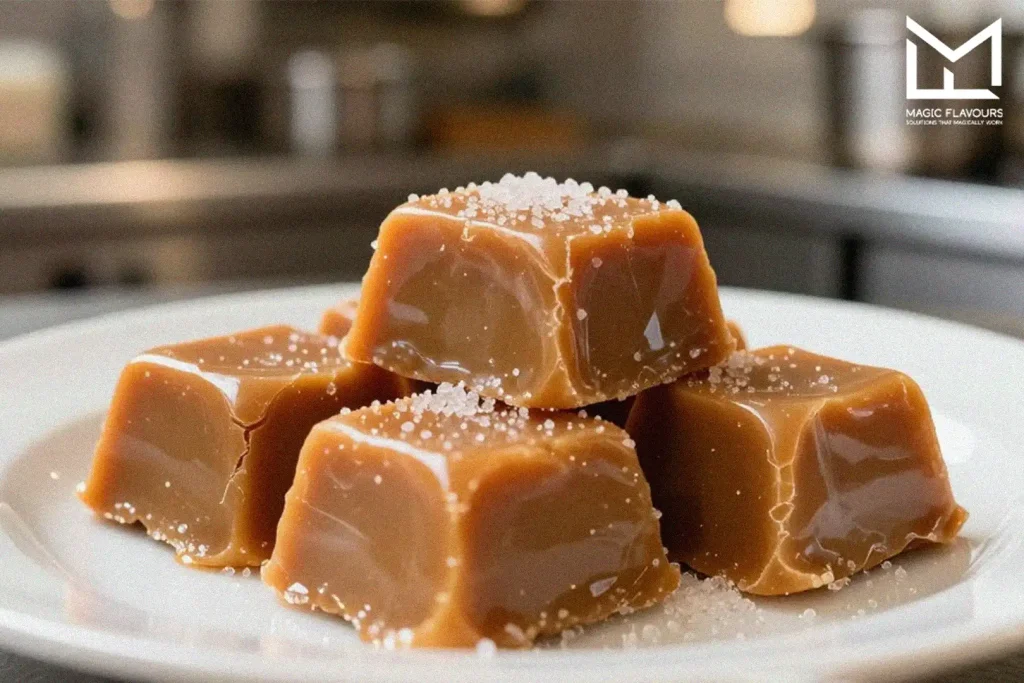
No, caramelization and the Maillard reaction are different chemical processes. Caramelization involves only sugar molecules breaking down under heat. In contrast, the Maillard reaction occurs between amino acids and reducing sugars. Therefore, Maillard produces browning in proteins like meat or bread crusts.
While both create flavor and color, their mechanisms differ. Because caramelization uses pure sugar, it generates sweet, nutty, and slightly bitter notes. Consequently, desserts and candies rely on caramelization, whereas savory foods often use Maillard browning.
Understanding the distinction helps cooks control flavor development. So, recognizing which reaction occurs ensures both desserts and savory dishes reach their full potential.
Can Sugar Caramelize Without Burning While Caramelizing?
Yes, sugar can caramelize without burning if heat is carefully controlled. Maintaining temperatures around 160–180°C allows sugar molecules to transform gradually. Therefore, caramel develops golden color and rich flavor without bitterness.
Using a heavy-bottomed pan or slow heat helps distribute temperature evenly. Because uneven heat can create hotspots, sugar may burn in some areas while caramelizing in others. Consequently, careful monitoring ensures consistent caramelization.
This controlled approach allows chefs to achieve perfect caramel in desserts and sauces. So, understanding heat management is key to caramelizing sugar successfully.
What temperature does sugar caramelize?
Sugar typically begins caramelizing between 160°C and 180°C. Within this range, sucrose molecules break down into glucose and fructose. Therefore, reaching the correct temperature is essential for chemical transformation.
Below 160°C, sugar only melts without forming new compounds. Because no flavor, aroma, or color develops, the change is purely physical. Consequently, proper heat ensures caramelization rather than just melting.
Above 180°C, sugar can burn quickly, producing bitterness and dark color. So, monitoring temperature carefully is critical to achieve golden caramel and rich flavors.
Is caramelization reversible?
No, caramelization is not reversible because it creates entirely new compounds. Once sugar molecules break down into glucose, fructose, and other products, they cannot return to their original form. Therefore, the process permanently transforms the sugar.
The flavors, aromas, and colors that develop are unique to caramelization. Because these properties did not exist in raw sugar, they cannot be undone. Consequently, burnt or over-caramelized sugar cannot be restored to its original sweetness.
Understanding this irreversibility helps cooks control heat and timing. So, caramelization requires careful attention to achieve perfect flavor without overdoing it.
9. Conclusion: Sweet Chemistry in Action While Caramelizing Sugar
caramelization transforms sugar through a fascinating chemical process. Heat breaks down sucrose into glucose, fructose, and hundreds of new compounds. Therefore, the flavors, aromas, and colors we enjoy are products of chemistry.
Unlike melting, caramelization is irreversible and creates entirely new substances. Because of this, it clearly qualifies as a chemical change. Consequently, every caramel candy, crème brûlée, and caramelized onion is a real-life example of science in action.
Understanding caramelization allows cooks to control flavor, color, and aroma. So, whether in a professional kitchen or at home, appreciating the chemistry behind caramel enriches both cooking and culinary creativity.
FAQs
1. When we dissolve sugar into coffee, are we observing a physical or chemical change? In other words, is dissolving sugar into coffee a physical or chemical change?
Dissolving sugar into coffee is a physical change. This is because the sugar molecules do not change their chemical structure — they only spread evenly throughout the coffee. If the water evaporates, the sugar can be recovered in its original form, showing that no new substance was formed.
2. When we heat sugar to make caramel for caramel apples, are we observing a physical or chemical change? In other words, is burning sugar for caramel apples a physical or chemical change?
Burning sugar for caramel apples is a chemical change. When sugar is heated, it decomposes and new substances are formed, producing the brown color, caramel flavor, and distinct aroma of caramel. These changes cannot be reversed to get the original sugar back, which shows that a chemical reaction has occurred.
3. When sugar is melted by heating it, are we observing a physical or chemical change? In other words, is melting sugar a chemical change?
Melting sugar is a physical change — as long as the sugar only melts and does not start to burn or caramelize. In this process, sugar changes from a solid to a liquid due to heat, but its chemical composition (sucrose) remains the same. However, if the temperature continues to rise and the sugar starts to turn brown, that would become a chemical change because new substances are then formed.
4. When sugar is heated and turns brown while developing a new flavor and aroma, are we observing a physical or chemical change? In other words, is caramelization a chemical change?
Caramelization is a chemical change. When sugar is heated, its molecules break down and form new compounds that give caramel its characteristic color, taste, and smell. Because new substances are produced and the change cannot be reversed to recover the original sugar, caramelization is considered a chemical change.
5. When sugar is burned while making caramel for caramel apples, are we observing a physical or chemical change? In other words, is burning sugar for caramel apples a physical or chemical change?
Burning sugar for caramel apples is a chemical change. When sugar burns, it reacts with oxygen and forms new substances such as carbon and water vapor. The color darkens, the smell changes, and the process cannot be reversed to get the original sugar back — all clear signs of a chemical change.
6. Is burning sugar for caramel apples a chemical change?
Yes, burning sugar for caramel apples is a chemical change. When sugar is heated until it burns, its molecules break down and react with oxygen to form new substances such as carbon and water vapor. This process produces a dark color, a burnt smell, and cannot be reversed to return the sugar to its original form — all of which indicate a chemical change.
7. Is sugar caramelizing a chemical change?
Yes, sugar caramelizing is a chemical change. When sugar is heated, its molecules break down and recombine to form new compounds that give caramel its golden color, rich flavor, and distinctive aroma. Because these new substances are created and the process cannot be reversed to get the original sugar back, caramelization is considered a chemical change.
8. Is sugar melting a chemical change?
No, sugar melting is a physical change. When sugar melts, it changes from a solid to a liquid due to heat, but its chemical structure (sucrose) stays the same. No new substances are formed, and if the liquid sugar cools down, it can return to its solid state — showing that melting sugar is a reversible physical change.
9. Is heating sugar a chemical or physical change?
Heating sugar can be either a physical or a chemical change, depending on how much heat is applied. If sugar is gently heated and only melts, it’s a physical change because its chemical structure stays the same. However, if the heat continues and the sugar starts to turn brown or caramelize, it becomes a chemical change — new substances form, producing the distinct color, flavor, and aroma of caramel.
10. Is melting sugar a physical change?
Yes, melting sugar is a physical change. When sugar is heated just enough to melt, it changes from a solid to a liquid, but its chemical composition (sucrose) remains the same. No new substances are formed, and if the melted sugar cools, it can solidify again — showing that the change is physical and reversible.
